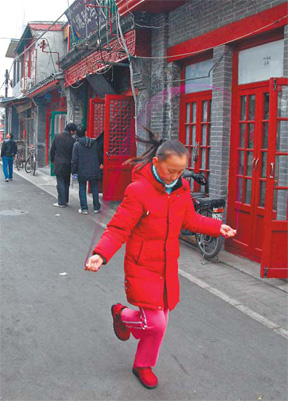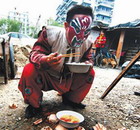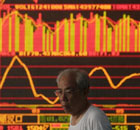Expats
Film explores city's past
By Lara Farrar (China Daily)
Updated: 2010-02-22 11:19
 |
Large Medium Small |
It is a documentary that raises deep questions about the rapid development Beijing continues to witness: What are the human costs? Has the historical memory of the city been irrevocably erased? Is the capital an experimental laboratory for Western architects? And what are the consequences?
|
 A girl plays in an old hutong in Qianmen area. Courtesy of Film Projects |
New Beijing-Reinventing a City offers no concrete answers to such questions. Instead the film raises awareness that these questions exist, and they are pressing, and that someone needs to be trying to solve them.
"The film is seeking to leave people with some questions and some unease about the scale of development and who is in charge," said Georgia Wallace-Crabbe, director of the 52-minute documentary. "Beijing is becoming a huge megalopolis and is losing its character. It was once a city that was very distinctive."
Wallace-Crabbe, a filmmaker from Sydney, Australia, began shooting New Beijing in the run up to the 2008 Olympics, a time when the city experienced unprecedented demolition and reconstruction.
More importantly, however, Wallace-Crabbe continued documenting redevelopment after the Olympics, a period when most thought the pace of change would slow but has not.
She interweaves contrasting narratives within the film, concocting a complicated picture of a city struggling to find a new identity on the global stage while at the same time neglecting the historical foundations on which it once so strongly stood.
On one side, there are interviews with Western architects who have flocked to Beijing, erecting monolithic projects such as the Central China Television (CCTV) complex, the National Center for the Performing Arts (NCPA), the Bird's Nest (National Stadium) and the Water Cube (National Aquatics Center).
The architects discuss their landmark structures, why they came to China to build them, and what it has been like to work in Beijing.
"The stadium has been slightly controversial in architectural terms," says Tristram Carfrae, engineering design leader with ARUP, the design firm that participated in the development of the Water Cube. "Several professors of architecture at local universities are saying it is not Chinese, and the government should not have employed Westerners as the designers."
"They may not be classically Chinese but there is some fusion, and therefore highly appropriate as China moves forward," he says in the film.
"[The Chinese] are in a situation where they are catching up. You know when you catch up, it is always the same thing; you can do it very wisely or you can do it impatiently," Paul Andreu, architect of the NCPA says in an interview.
"We [architects] are serious people, we don't play games as some people may think. It is a good place, it is a very good place," Andreu says.
Others featured in the documentary, including Zhang Jingqi, disagree.
Zhang, a local resident who initiated "Memory of China," a photo exhibition showing vanishing cultural heritage in Beijing and other cities, represents a less visible side of the redevelopment - a population quietly being swept elsewhere, forced to move from disappearing neighborhoods, struggling to grasp a heritage that is quickly fading away.
Wallace-Crabbe follows Zhang through Qianmen and other old districts facing demolition. They encounter people whose homes are to be imminently demolished, places where historical buildings have disappeared overnight and twinges of anger among Beijingers who feel like they have been disenfranchised by the government.
"[The development] seriously damages the memory of the city," says Zhang. "In the future, everything will be fake."
Is it too late to reconcile the seemingly disparate paths of rapid development with historical preservation? New Beijing leans towards the answer of yes. But ultimately it is up for viewers to decide that answer and to determine whether something should be done about it.
For more information on the film, visit www.filmprojects.com.au.







